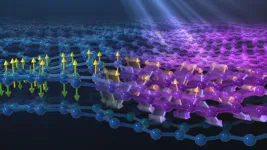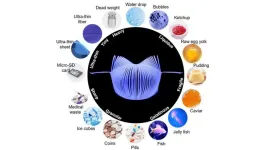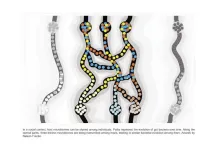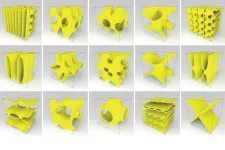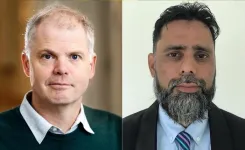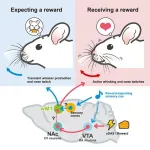(Press-News.org) A common metal paper clip will stick to a magnet. Scientists classify such iron-containing materials as ferromagnets. A little over a century ago, physicists Albert Einstein and Wander de Haas reported a surprising effect with a ferromagnet. If you suspend an iron cylinder from a wire and expose it to a magnetic field, it will start rotating if you simply reverse the direction of the magnetic field.
“Einstein and de Haas’s experiment is almost like a magic show,” said Haidan Wen, a physicist in the Materials Science and X-ray Science divisions of the U.S. Department of Energy’s (DOE) Argonne National Laboratory. “You can cause a cylinder to rotate without ever touching it.”
“In this experiment, a microscopic property, electron spin, is exploited to elicit a mechanical response in a cylinder, a macroscopic object.” — Alfred Zong, Miller Research Fellow at the University of California, Berkeley.
In Nature magazine, a team of researchers from Argonne and other U.S. national laboratories and universities now report an analogous yet different effect in an “anti”-ferromagnet. This could have important applications in devices requiring ultra-precise and ultrafast motion control. One example is high-speed nanomotors for biomedical applications, such as use in nanorobots for minimally invasive diagnosis and surgery.
The difference between a ferromagnet and antiferromagnet has to do with a property called electron spin. This spin has a direction. Scientists represent the direction with an arrow, which can point up or down or any direction in between. In the magnetized ferromagnet mentioned above, the arrows associated with all the electrons in the iron atoms can point in the same direction, say, up. Reversing the magnetic field reverses the direction of the electron spins. So, all arrows are pointing down. This reversal leads to the cylinder’s rotation.
“In this experiment, a microscopic property, electron spin, is exploited to elicit a mechanical response in a cylinder, a macroscopic object,” said Alfred Zong, a Miller Research Fellow at the University of California, Berkeley.
In antiferromagnets, instead of the electron spins all pointing up, for example, they alternate from up to down between adjacent electrons. These opposite spins cancel each other out, and antiferromagnets thus do not respond to changes in a magnetic field as ferromagnets do.
“The question we asked ourselves is, can electron spin elicit a response in an antiferromagnet that is different but similar in spirit to that from the cylinder rotation in the Einstein-de Hass experiment?” Wen said.
To answer that question, the team prepared a sample of iron phosphorus trisulfide (FePS3), an antiferromagnet. The sample consisted of multiple layers of FePS3, with each layer being only a few atoms thick.
“Unlike a traditional magnet, FePS3 is special because it is formed in a layered structure, in which the interaction between the layers is extremely weak,” said Xiaodong Xu, professor of physics and materials science at the University of Washington.
“We designed a set of corroborative experiments in which we shot ultrafast laser pulses at this layered material and measured the resultant changes in material properties with optical, X-ray, and electron pulses,” Wen added.
The team found that the pulses change the magnetic property of the material by scrambling the ordered orientation of electron spins. The arrows for electron spin no longer alternate between up and down in an orderly fashion, but are disordered.
“This scrambling in electron spin leads to a mechanical response across the entire sample. Because the interaction between layers is weak, one layer of the sample is able to slide back and forth with respect to an adjacent layer,” explained Nuh Gedik, professor of physics at the Massachusetts Institute of Technology (MIT).
This motion is ultrafast, 10 to 100 picoseconds per oscillation. One picosecond equals one trillionth of a second. This is so fast that in one picosecond, light travels a mere third of a millimeter.
Measurements on samples with spatial resolution on the atomic scale and temporal resolution measured in picoseconds require world-class scientific facilities. To that end, the team relied on cutting-edge ultrafast probes that use electron and X-ray beams for analyses of atomic structures.
Motivated by optical measurements at the University of Washington, the initial studies employed the mega-electronvolt ultrafast electron diffraction facility at SLAC National Accelerator Laboratory. Further studies were performed at an ultrafast electron diffraction setup at MIT. These results were complemented by work at the ultrafast electron microscope facility in the Center for Nanoscale Materials (CNM) and the 11-BM and 7-ID beamlines at the Advanced Photon Source (APS). Both CNM and APS are DOE Office of Science user facilities at Argonne.
The electron spin in a layered antiferromagnet also has an effect at longer times than picoseconds. In an earlier study using APS and CNM facilities, members of the team observed that fluctuating motions of the layers slowed down dramatically near the transition from disordered to ordered behavior for the electron spins.
“The pivotal discovery in our current research was finding a link between electron spin and atomic motion that is special to the layered structure of this antiferromagnet,” Zong said. “And because this link manifests at such short time and tiny length scales, we envision that the ability to control this motion by changing the magnetic field or, alternatively, by applying a tiny strain will have important implications for nanoscale devices.”
This research appeared in Nature. Besides Wen, Zong, Xu, and Gedik, other authors include Qi Zhang, Faran Zhou, Yifan Su, Kyle Hwangbo, Xiaozhe Shen, Qianni Jiang, Haihua Liu, Thomas Gage, Donald Walko, Michael E. Kozina, Duan Luo, Alexander Reid, Jie Yang, Suji Park, Saul Lapidus, Jiun-Haw Chu, Ilke Arslan, Xijie Wang and Di Xiao.
This work was primarily supported by the DOE Office of Basic Energy Sciences.
About the Advanced Photon Source
The U. S. Department of Energy Office of Science’s Advanced Photon Source (APS) at Argonne National Laboratory is one of the world’s most productive X-ray light source facilities. The APS provides high-brightness X-ray beams to a diverse community of researchers in materials science, chemistry, condensed matter physics, the life and environmental sciences, and applied research. These X-rays are ideally suited for explorations of materials and biological structures; elemental distribution; chemical, magnetic, electronic states; and a wide range of technologically important engineering systems from batteries to fuel injector sprays, all of which are the foundations of our nation’s economic, technological, and physical well-being. Each year, more than 5,000 researchers use the APS to produce over 2,000 publications detailing impactful discoveries, and solve more vital biological protein structures than users of any other X-ray light source research facility. APS scientists and engineers innovate technology that is at the heart of advancing accelerator and light-source operations. This includes the insertion devices that produce extreme-brightness X-rays prized by researchers, lenses that focus the X-rays down to a few nanometers, instrumentation that maximizes the way the X-rays interact with samples being studied, and software that gathers and manages the massive quantity of data resulting from discovery research at the APS.
This research used resources of the Advanced Photon Source, a U.S. DOE Office of Science User Facility operated for the DOE Office of Science by Argonne National Laboratory under Contract No. DE-AC02-06CH11357.
Argonne National Laboratory seeks solutions to pressing national problems in science and technology. The nation’s first national laboratory, Argonne conducts leading-edge basic and applied scientific research in virtually every scientific discipline. Argonne researchers work closely with researchers from hundreds of companies, universities, and federal, state and municipal agencies to help them solve their specific problems, advance America’s scientific leadership and prepare the nation for a better future. With employees from more than 60 nations, Argonne is managed by UChicago Argonne, LLC for the U.S. Department of Energy’s Office of Science.
The U.S. Department of Energy’s Office of Science is the single largest supporter of basic research in the physical sciences in the United States and is working to address some of the most pressing challenges of our time. For more information, visit https://energy.gov/science.
END
Scientists discover unusual ultrafast motion in layered magnetic materials
Discovery inspired by experiments of Einstein and de Haas
2023-08-02
ELSE PRESS RELEASES FROM THIS DATE:
New review calls on Hockey Canada to raise age of body contact from 13 to 15
2023-08-02
Hockey leagues in Canada should overhaul current rules and regulations to raise the age of bodychecking in the game from 13 to 15, says new research into the effect of body contact on teens.
The literature review was led by Dr. Kristian Gouletnorth_eastexternal link of the University of Ottawa’s Faculty of Medicine and Children’s Hospital of Eastern Ontario (CHEO) and calls on provincial and territorial governments to mandate schools – including those involved with school sports – and sports organizations to establish, ...
Robotic grippers offer unprecedented combo of strength and delicacy
2023-08-02
Researchers at North Carolina State University have developed a robotic gripping device that is gentle enough to pick up a drop of water, strong enough to pick up a 6.4 kilogram (14.1 pound) weight, dexterous enough to fold a cloth, and precise enough to pick up microfilms that are 20 times thinner than a human hair. In addition to possible manufacturing applications, the researchers also integrated the device with technology that allows the gripper to be controlled by the electrical signals produced by muscles in the forearm, demonstrating its potential for use with robotic prosthetics.
“It is difficult ...
The Power of host social interactions in bacterial evolution
2023-08-02
Previous studies in humans and animals showed that hosts in a social condition (sharing the same space) harbor a more similar microbiota composition. Microbial transmission between hosts, which is increased when living in the same household, leads to similar species inhabiting the gut. However, whether bacterial evolution in the gut is affected by microbiota transmission remained unknown.
To fill this knowledge gap, the researchers used an innovative in vivo experimental evolution approach, which revealed an average transmission rate ...
Waves of charge signal rare physics at work inside a superconductor
2023-08-02
‘A place for everything and everything in its place’–making sense of order, or disorder, helps us understand nature. Animals tend to fit nicely into categories: Mammals, birds, reptiles, whatever an axolotl is, and more. Sorting also applies to materials: Insulator, semiconductor, conductor, and even superconductor. Where exactly a material lands in the hierarchy depends on a seemingly invisible interplay of electrons, atoms, and their surroundings.
Unlike animals, the boundaries are less sharp, and tweaking a material’s ...
New method simplifies the construction process for complex materials
2023-08-02
Engineers are constantly searching for materials with novel, desirable property combinations. For example, an ultra-strong, lightweight material could be used to make airplanes and cars more fuel-efficient, or a material that is porous and biomechanically friendly could be useful for bone implants.
Cellular metamaterials — artificial structures composed of units, or cells, that repeat in various patterns — can help achieve these goals. But it is difficult to know which cellular structure will lead to the desired properties. Even if one focuses on structures made of smaller building blocks like interconnected beams or ...
Dimensions to boost discoverability of Oxford University Press online journals and books
2023-08-02
The world’s largest linked research database, Dimensions, will grow its knowledge base even further, thanks to a new partnership with the world’s largest university press, Oxford University Press (OUP).
Under the agreement, more than 27,000 books and 500 journal titles from OUP’s Oxford Academic digital publishing platform will be fully indexed and discoverable in Dimensions, adding another rich resource of academic material to the world’s largest research database, in fields such as the arts, humanities, economics, science, technology, history, and politics.
The move will enable users of Dimensions – a flagship Digital Science product – ...
A visual feast
2023-08-02
3D light sculptures. Tsunami waves on a beach. Previewing color tattoos. Contributions from the Bickel and Wojtan groups at the Institute of Science and Technology Austria (ISTA) to the 2023 SIGGRAPH conference tackle an impressive variety of classic and novel questions. While their focuses range from computer graphics to fabrication methods, the computer scientists are united in finding cost-effective, innovative solutions and empowering users.
SIGGRAPH is the top worldwide annual convention for computer graphics and interactive techniques, bringing ...
Important step toward next-generation probiotics
2023-08-02
One of the beneficial gut bacteria residing in the human gut, which normally cannot survive in an environment with oxygen, can now be made oxygen-tolerant. This is a key finding in the development of future probiotic treatment that is now being explored to improve glucose control in individuals with prediabetes.
Our intestines are home to trillions of bacteria, the gut microbiota, which are important for functions such as digesting food and educating and activating the immune system. During the past decade it has been clarified that changes in the bacterial composition can be linked to various diseases.
Significant expectations have been attributed to the next generation ...
Infertility may lead to more severe menopause symptoms
2023-08-02
CLEVELAND, Ohio (August 2, 2023)—Not all women experience menopause the same way. The severity of menopause symptoms is influenced by a multitude of behavioral, biological, social, psychological, and demographic factors. A new study suggests that infertility may also be a risk factor for some menopause symptoms, including depressive mood, irritability, and sleep problems. Results of the study are published online today in Menopause, the journal of The Menopause Society.
A woman’s reproductive history has been implicated as a factor in the timing of menopause onset and the prevalence of menopause ...
Unveiling the mechanism underlying orofacial movements during reward processing in animals
2023-08-02
In animals, movements such as locomotion or grooming are known to influence neuronal activity within the cerebral cortex. Moreover, recent studies also suggest that these changes in neuronal activity are not confined to a specific area but are pervasive throughout cortical and subcortical regions of the brain. Interestingly, in animals trained for reward-based learning tasks, such spontaneous movements—despite being uninstructed and unnecessary—may be aligned to task events and may significantly contribute to ...
LAST 30 PRESS RELEASES:
Why nail-biting, procrastination and other self-sabotaging behaviors are rooted in survival instincts
Regional variations in mechanical properties of porcine leptomeninges
Artificial empathy in therapy and healthcare: advancements in interpersonal interaction technologies
Why some brains switch gears more efficiently than others
UVA’s Jundong Li wins ICDM’S 2025 Tao Li Award for data mining, machine learning
UVA’s low-power, high-performance computer power player Mircea Stan earns National Academy of Inventors fellowship
Not playing by the rules: USU researcher explores filamentous algae dynamics in rivers
Do our body clocks influence our risk of dementia?
Anthropologists offer new evidence of bipedalism in long-debated fossil discovery
Safer receipt paper from wood
Dosage-sensitive genes suggest no whole-genome duplications in ancestral angiosperm
First ancient human herpesvirus genomes document their deep history with humans
Why Some Bacteria Survive Antibiotics and How to Stop Them - New study reveals that bacteria can survive antibiotic treatment through two fundamentally different “shutdown modes”
UCLA study links scar healing to dangerous placenta condition
CHANGE-seq-BE finds off-target changes in the genome from base editors
The Journal of Nuclear Medicine Ahead-of-Print Tip Sheet: January 2, 2026
Delayed or absent first dose of measles, mumps, and rubella vaccination
Trends in US preterm birth rates by household income and race and ethnicity
Study identifies potential biomarker linked to progression and brain inflammation in multiple sclerosis
Many mothers in Norway do not show up for postnatal check-ups
Researchers want to find out why quick clay is so unstable
Superradiant spins show teamwork at the quantum scale
Cleveland Clinic Research links tumor bacteria to immunotherapy resistance in head and neck cancer
First Editorial of 2026: Resisting AI slop
Joint ground- and space-based observations reveal Saturn-mass rogue planet
Inheritable genetic variant offers protection against blood cancer risk and progression
Pigs settled Pacific islands alongside early human voyagers
A Coral reef’s daily pulse reshapes microbes in surrounding waters
EAST Tokamak experiments exceed plasma density limit, offering new approach to fusion ignition
Groundbreaking discovery reveals Africa’s oldest cremation pyre and complex ritual practices
[Press-News.org] Scientists discover unusual ultrafast motion in layered magnetic materialsDiscovery inspired by experiments of Einstein and de Haas
